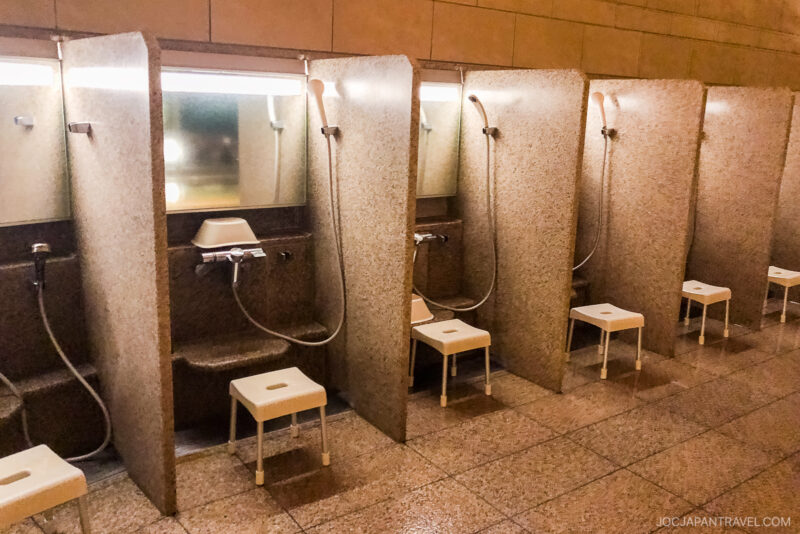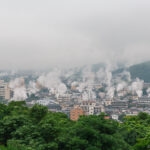This post may contain affiliate links. Please read our disclosure policy.
Soaking in an onsen is one of Japan’s most memorable experiences, where natural beauty, cultural rituals, and relaxation come together to rejuvenate both body and mind.

What Is an Onsen?
Onsen (温泉) means “hot spring,” and in Japan it refers to baths filled with natural geothermal waters. These springs contain minerals such as sulfur, sodium, and iron that are said to soothe muscles, improve circulation, and promote healthy skin.
Onsens are everywhere across Japan, especially in areas with volcanic activity. Some are tucked in mountain valleys, others overlook the ocean, and many are attached to traditional ryokan inns. Prices vary, but you don’t always need to stay overnight as many facilities welcome day visitors.
It’s important to note that onsens are regulated under Japanese law to ensure water quality. The Ministry of the Environment officially recognizes thousands of springs, and each claims unique health benefits.
Onsen in Japanese Culture

Bathing is more than relaxation—it’s part of Japan’s spiritual and cultural fabric. Ancient texts like the Kojiki and Manyoshu mention hot springs, and purification rituals in both Shinto and Buddhism highlight the healing role of water.
Even animals have been spotted enjoying the warmth. At Jigokudani Monkey Park in Nagano, wild macaques soak in outdoor baths in winter, delighting visitors from around the world.
Best Onsen Towns in Japan

With so many to choose from, these six regions are among the most famous:
Noboribetsu Onsen (登別温泉), Hokkaido
Known as the “department store of hot springs,” Noboribetsu offers seven different mineral waters. The milky, sulfuric baths were first used by the indigenous Ainu people.
Kusatsu Onsen (草津温泉), Gunma
One of Japan’s most popular hot spring towns, Kusatsu is famed for its powerful sulfur springs. Don’t miss the Yubatake, where thousands of liters of steaming water gush out every minute.
Atami Onsen (熱海温泉), Shizuoka
Just 35 minutes from Tokyo by bullet train, Atami combines coastal scenery with 1,000 years of bathing history. Even shogun Tokugawa Ieyasu was a loyal visitor.
Gero Onsen (下呂温泉), Gifu
Nicknamed the “beauty hot springs,” Gero’s clear alkaline water is said to soften skin. The town has several free footbaths, and even an open-air public bath by the river.
Arima Onsen (有馬温泉), Hyogo
Near Kobe and Osaka, Arima is one of Japan’s oldest and most prestigious resorts. It features two distinct waters: gold (iron-rich) and silver (radium-carbonate).
Beppu Onsen (別府温泉), Oita
Beppu is famous for its sheer number of hot springs. Walking through town, you’ll see steam rising everywhere. The dramatic “hells” (jigoku) are scalding hot pools best admired rather than bathed in.
How to Use an Onsen

Bathing rules may seem strict, but they ensure everyone enjoys the experience:
- Change & Wash: In the changing room, remove all clothing. At the washing area, sit on the stool and scrub thoroughly before entering the bath.
- No Towels in the Water: You may carry a small towel for modesty, but it should never touch the bathwater.
- Soak Quietly: No splashing, swimming, or loud talking. Long hair must be tied up.
- Exit & Dry: Some onsens suggest not rinsing off afterward, to let the minerals stay on your skin.
Onsen Etiquette Questions

Photos: Cameras and phones are never allowed inside shared baths.
Tattoos: Some facilities still ban tattoos, though attitudes are slowly changing. Covering small tattoos with a bandage or choosing a private onsen is a safe option.
Children: Many onsens allow children, but rules vary by age or height. Private baths are best for families who want to soak together.
Clothing: Bathing suits are not allowed in standard onsens. Exceptions exist for mixed-gender baths or natural outdoor pools.
Is Visiting an Onsen Worth It?

Bathing in an onsen is one of the most authentic Japanese experiences you can have. The mineral-rich waters soothe your body, while the cultural traditions give you a deeper sense of connection to Japan. Whether you choose a famous resort town like Beppu or a quiet mountain inn, it’s an experience that stays with you long after your trip.





Nami, first, your timing for your new site is perfect for us, as we are going to Japan in the first few weeks of December (1.5 months from now). And even more important, this post! I have searched and searched, and could not find ANYTHING on the etiquette of an onsen. Thank you!
Hi Katie!
Thank you so much for your feedback, and we’re so glad the onsen post was helpful. Where will you be visiting?